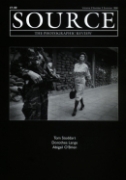First Event
The Shoreditch 'First Event' was held during April, 1996, in East London
Review by Patricia Lambe
Issue 8 Summer 1996
View Contents ▸
The Shoreditch 'First Event' was held during April in East London. It 'launched the concept of the first Shoreditch Foto Biennale', an international photography festival to be held in 1998. Organised in conjunction with Creative Camera magazine, 'First Event' was in fact an ambitious and well organised series of events which included six exhibitions, a day of studio visits, artists presentations and a curators' meeting. Delegates attended from the UK, Belgium, India, Ireland, Italy, Germany and the Netherlands. Exhibitions were held over a diverse range of sites, from vacant shop units and builders' hoardings to local galleries.
Three photographers showed their work at the temporary FotoBiennale Gallery. Chris Harrison presented 'Under the Hood', a series of portraits of young men living in Jarrow. Beautifully composed, he employed the conventions of 'old masters' painting to subvert stereotypical representations. Gareth McConnell's 'Anti-Social Behaviour' displayed a cool and dispassionate approach to an emotive subject. His large colour images clinically focused on the scarred bodies of victims of paramilitary violence in Northern Ireland. The objective documentation of wounds and scars is reminiscent of Andrea Serrano's Morgue series, seen recently in 'The Dead' exhibition. Removed from any political context and avoiding a photojournalistic approach, the images presented, in a neutral space without reference to allegiance or event, touch the viewer in an immediate way. Similarly Clare Strand's 'Morgue' images of postmortem equipment avoided sensationalism. They were photographed in a quiet, objective manner with the captions explaining the invasive tools of the trade. Gareth McConnell
Gareth McConnell
Three other bodies of work were exhibited in temporary locations. Anna Fox's 'Afterwards' photographs depicted the chaos of the morning after the night before. These were hung on builders' hoardings in Hoxton Square in the full and cruel light of day. They were shown alongside contrastingly fresh and innocent portraits from the George Garland collection. Another exhibition at the Standpoint Gallery brought together six more artists, namely Ben Judd, David Thorpe, Brian Griffiths and Christopher Aughton. In all the studio visits and artists presentations were well structured to provide the delegates with an opportunity to meet artists from diverse areas of photographic practice. In the morning I attended three artists' presentations whose success depended on the quality of the work and their individual delivery skills, in itself another talent. Max Jourdan gave the first presentation. His work was very well composed but functioned only on an aesthetic level to lack real content. Rainer Usselmann used computer enhanced video stills to construct alien like templates from a stock library of thousands of images. However, the process was more interesting than the resulting images. The most arresting presentation was given by Stephen Bull whose playful reappropriation of 'found' imagery, unwanted group portraits from Madame Tussauds' and the reworking of his family album raised questions about the role and position of photography in contemporary life. Anna Fox
Anna Fox
In the afternoon we visited three artists' studios. Rut Blees Luxembourg introduced us to her investigation of the psychological space of the City of London at night. Working with another photographer, Rut went to this predominately male bastion where photographs were made of the interaction between herself and the people (mostly men) she met. Through her choice of dress and make-up, the photographs presented her as an object of desire which lent an air of fantasy and glamour to the images. As a result the work resembled the style of setup scenarios of contemporary fashion editorials and distracted the viewer from the original intention. We also visited Peter Kennard's studio who is well known for his political montages and Frank Rogers, a photographer concerned with issues of black representation.
At the curators' meeting, invited speakers such as Bas Vroeg, from Enschede Biennale in Holland, Hilde Van Leuven, from the International Cultural Centrum in Amsterdam, Simon Grennan from the Viewpoint Gallery in Salford and Satish Sharma, a photographer, critic and curator from India, discussed their individual approaches to 'curating the photographic image'. Satish gave the most interesting presentation of the 'First Event'. He showed work that he had curated from images made in Indian photo-booths (this work was exhibited at Fotofeis in Scotland last October). The images were the work of photographers known as 'Rutigraphs' or 'Bread Photographers' who, as their name suggests earn their living as commercial photographers working from studios and booths in India. Subjects have photographs taken beside effigies of their favourite film-stars, enact religious role-plays in front of painted backdrops or pose with objects which denote material wealth. This fantastic world of illusion, constructed by the photographer and customer, reflects personal belief systems. As a result the work manages to transcend the merely exotic or strange to connect with the aspirations and values of those portrayed.
Throughout this work, Satish confronts the notion that 'unless you are trained you reinvent the wheel'. He discussed the role-play by photography in formulating cultural identity in a country where colonial perceptions remain. The issue of Eurocentrism and exoticism was opened out into a lively debate. Martin Parr questioned whether we were suffering from a sense of guilt which is manifested in the blanket taking up of 'ethnic' work. Many of the curators agreed with the suggestion that sight for the discourse around cultural identity and representation had moved from the media to the gallery space.
Ultimately, 'First Event' succeeded in offering a variety of platforms for photographers to show their work in spaces ranging from the intimate to the public. Shoreditch is away from the chaos and noise of Central London. This helped to create a friendly and relaxed atmosphere to show and discuss photography. Based on this, the first Shoreditch Biennial will be worth attending.
Other articles mentioning Gareth McConnell:
Other articles mentioning Anna Fox:
Other articles on photography from the 'Multi-Genre' category ▸






